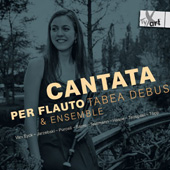
COLLECTIONS

Johann Adolph Hasse (1699–1783): Cantata per Flauto in B Major for Alto Recorder and basso continuo
Calliope Tsoupaki (born 1963): Charavgi for Renaissance Alto Recorder solo
Jacob van Eyck (ca. 1590–1657): Four Variations on Come again, sweet love doth now invite
Domenico Natale Sarro (1679–1744): Concerto in D minor per Flauto
Adam Jarzebski (1590–1649): Diligam Te Domine
Adam Jarzebski (1590–1649): Venite Exultemus
Thorsten Töpp (born 1965): a due - Double Portrait for Tenor Recorder and Cello
Georg Philipp Telemann (1681–1767): Concerto in C Major for Alto Recorder, Strings and basso continuo
Henry Purcell (1659–1695): An Evening Hymn
For many centuries, up until musical instruments were invented, improved upon and perfected, the human voice was the only medium, or intermediate tool that composers had at their disposal with
which to communicate with the audience. That would explain why, even after the advent of musical instruments, composers were writing instrumental music that would strive to simulate or
reproduce the human singing voice as much as possible. Or it may just be that they were so used to that style of writing that it took them a century or so to shake off the habit. At any rate,
all the pieces gathered together on this new CD certainly share a connection with the lyrical and melodic qualities of the singing voice, even if it includes actually singing into the recorder as the
pieces by Calliope Tsoupaki and Thorsten Töpp do.
One of the allures of this new recording is the fact that many of the works listed here have not often been previously recorded, and if I'm not mistaking, some may even be world première recordings.
But the main draw is without a doubt Tabea Debus and the way she plays no, commands, the recorder. She brings out the vocal quality of the music so well, that it often sounds
like birdsong more so than a wind instrument. Her technique is astounding, and most particularly her pristine articulation of each and every note and precise accenting are quite spellbinding. Especially
when you consider that she makes it all sound so musical. And she can go from expressing joy in the Domenico Natale Sarro to being morose in the Adam Jarzebski without a hitch. I should hope
that there are plenty of recordings planned with her in mind in the future, which should also include the top-notch ensemble supporting her comprised of Lea Rahel Bader, Johannes Lang,
Kohei Ota Theorbe, Hongxia Cui, Katrin Ebert, Kerstin Fahr, Johanna Brückner and Niklas Sprenger. They seem to anticipate her every move and react accordingly.
The only drawback here for me lies with the sequence of the pieces. Sorry Thorsten Töpp, this is not personal, but your work does not fit well between the music of Adam Jarzebski and
Georg Philipp Telemann, but rather breaks the 17th century mood. I don't see why they couldn't just simply have placed it last on the disc. Minor quibble.
Jean-Yves Duperron - July 2016